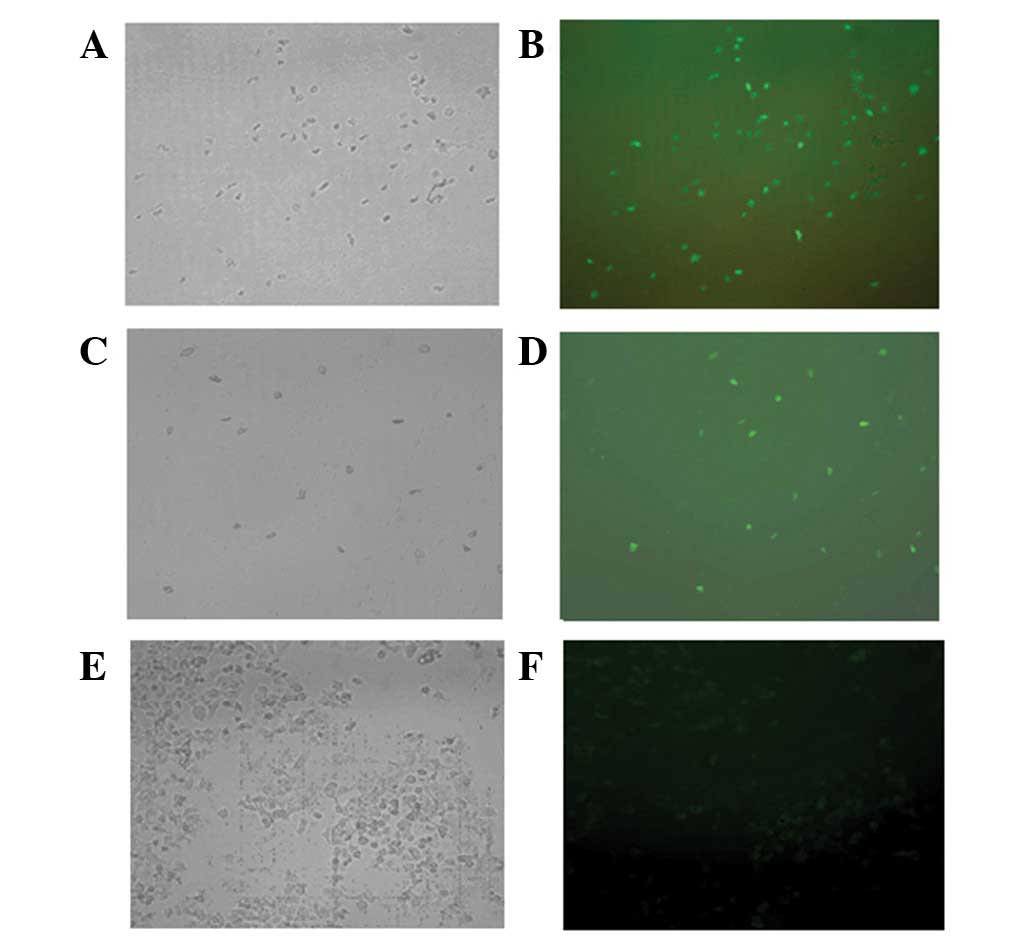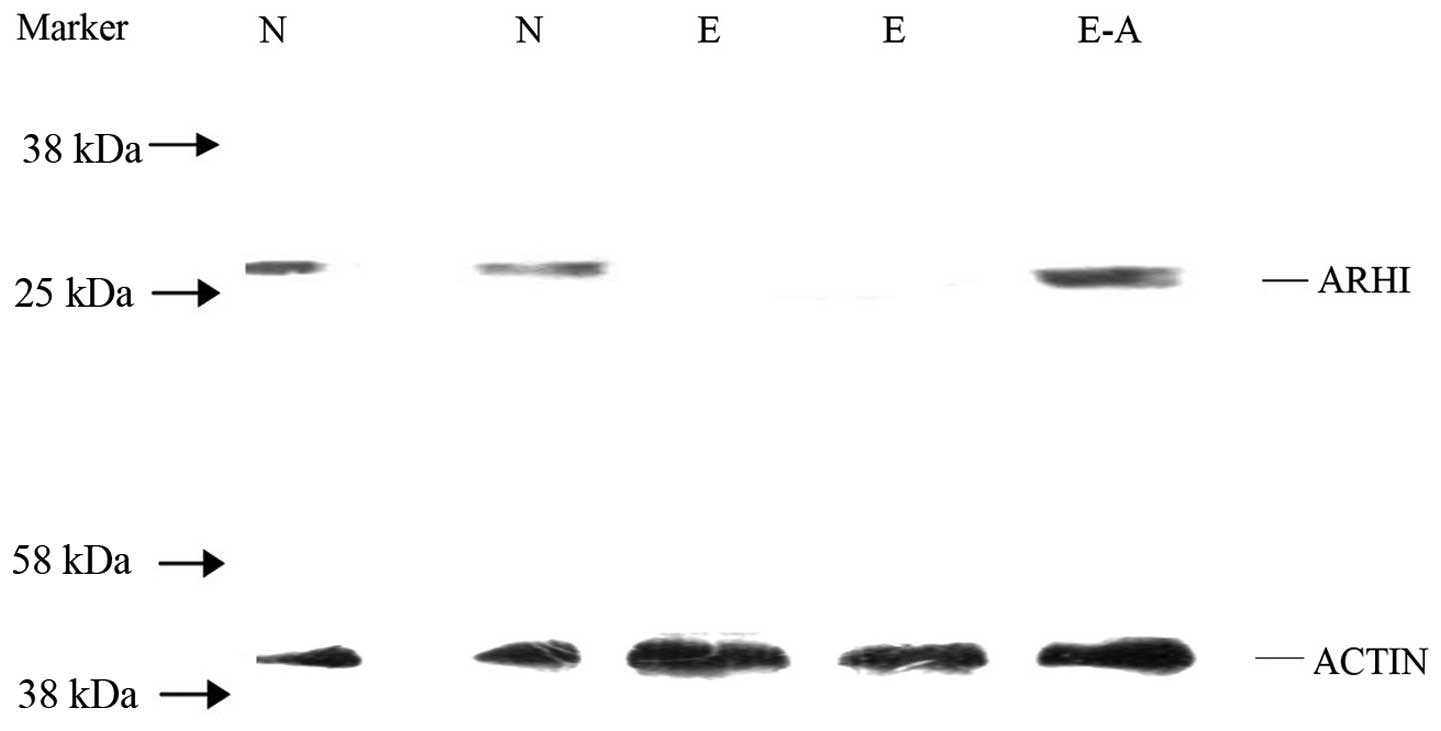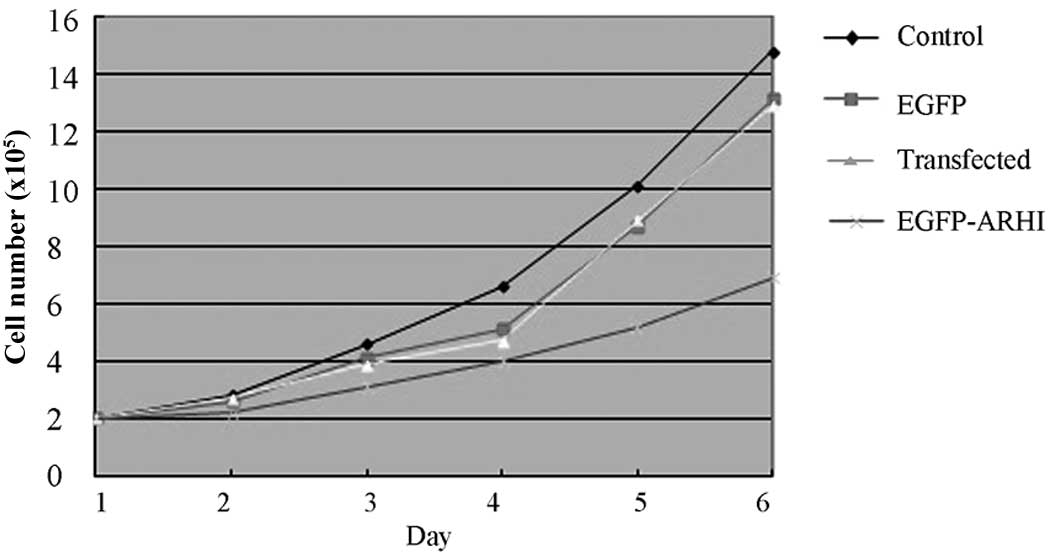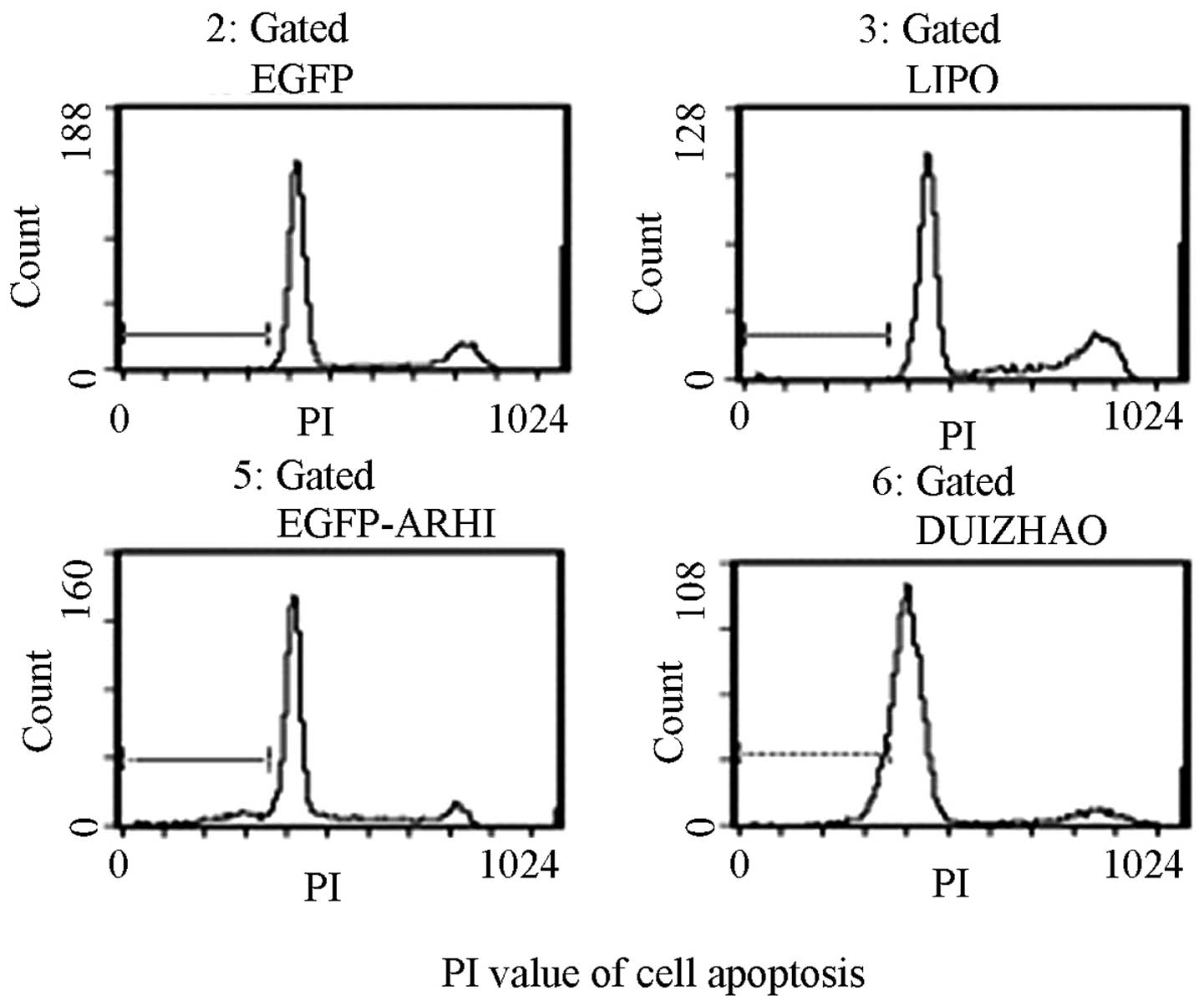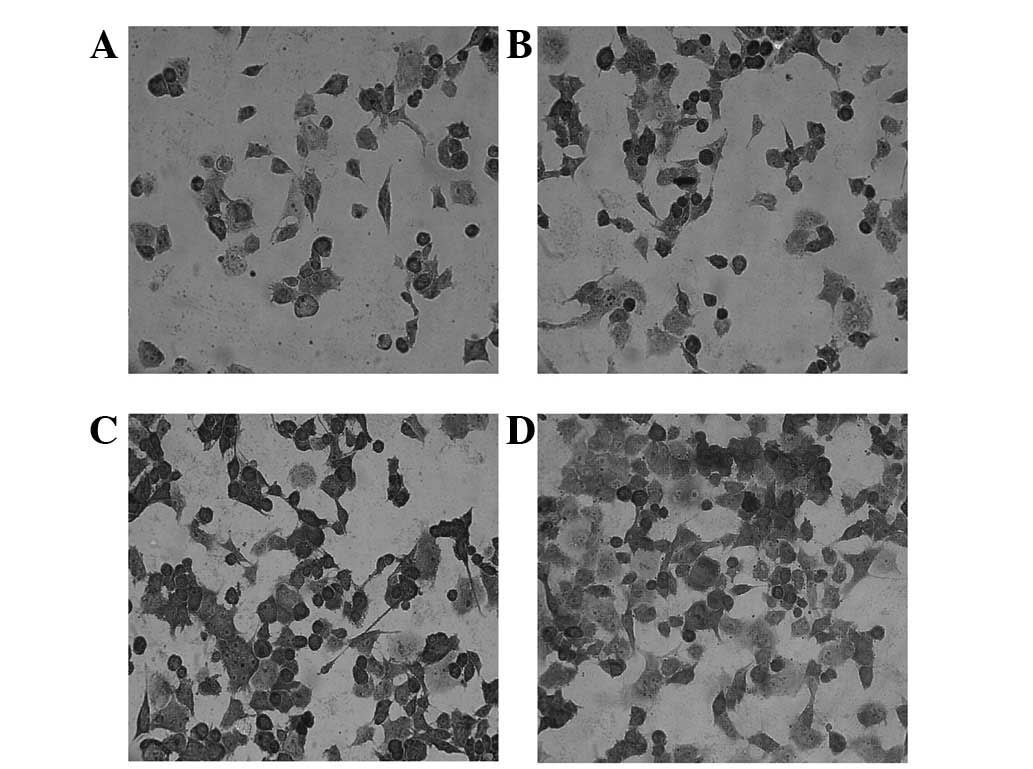Inhibitory effect of ARHI on pancreatic cancer cells and NF‑κB activity
- Authors:
- Published online on: February 26, 2013 https://doi.org/10.3892/mmr.2013.1342
- Pages: 1180-1184
Abstract
Introduction
Pancreatic cancer is one of the most malignant tumors. The morbidity and mortality rates caused by pancreatic cancer are on the increase in China and Western countries. Due to its poor prognosis and obscure etiology, pancreatic cancer is becoming a focus for medical science.
In humans, ARHI is a maternally imprinted suppressor encoding a 26-kDa small G protein. In ovarian and breast cancer, the expression of ARHI is usually downregulated (1), and in pancreatic tumors, recent studies (2) have shown that ARHI may be a tumor suppressor, however, the mechanism of its action has not been elucidated.
The progression of pancreatic cancer involves various stages and a number of genes. Although the signaling pathway involved during tumor development has not been elucidated, studies (3,4) have shown that the overactivation and expression of the NF-κB signaling pathway correlates with tumor formation, i.e., malignant tumors with increased NF-κB expression have been observed. The present study aimed to investigate the inhibitory effect of ARHI in the pancreatic cancer PANC-1 cells and identify the correlation between ARHI and the NF-κB signaling pathway.
Materials and methods
Cell culture
The human pancreatic cancer cell line, PANC-1, was cultured in RPMI-1640 medium (Gibco, Carlsbad, CA, USA) supplemented with 10% fetal calf serum (Hyclone, Waltham, MA, USA) at 5% CO2 and 37°C. The study was approved by the ethics committee of Zhongshan Hospital Affiliated to Xiamen University.
Reverse transcription (RT)-PCR
The total RNA was extracted from normal pancreatic tissue with the TRIzol reagent (Invitrogen, Carlsbad, CA, USA) according to the manufacturer's instructions. The coding sequence of ARHI was obtained by PCR using the primers: forward, 5′-CGG AATTCCGTATCTCCCCTCCGAATCC-3′ and reverse, 5′-CGGGATCCGCCCAGGGCTCACATGATT-3′. The PCR protocol was as follows: 35 cycles of amplification, each cycle consisting of denaturation at 94°C for 40 sec, annealing at 55°C for 40 sec and extension at 72°C for 1 min, prior to an additional extension at 72°C for 10 min. The 745 bp PCR product was purified using a DNA purifying kit.
Construction of the recombinant plasmid pIRES2-EGFP- ARHI and transient transfection
The eukaryotic expression vector pIRES2-EGFP and the ARHI PCR product were digested with EcoRI and BamHI. The digested products were purified and ligated with T4 ligase and transiently transfected into thePANC-1 cells using Lipofectamine™ 2000 according to the standard protocol. The transfected cells utilized in the various experiments were cultured for 24, 48, 72, 96 and 120 h.
Analysis of MTT cell growth assay
The PANC-1 cells utilized for transfection were divided into 4 groups: cells transfected with pIRES2-EGFP-ARHI, cells containing the empty vector pIRES2-EGFP, untreated PANC-1 cells as a control and the Lipofectamine™ 2000 transfection control group. For each group, 2×105 cells were seeded in triplicate in 6-well plates and cultured for 24, 48, 72, 96 and 120 h, followed by digestion with trypsinogen. The cell number was calculated each day and used to plot the growth curve.
Analysis of cell morphology and apoptosis by flow cytometry
At the 120 h time-point, the transfected PANC-1 cells were digested and washed 3 times with phosphate-buffered saline, collected by centrifugation and permeabilized in 70% ethanol (4°C) overnight. The permeabilized cells were then incubated for 30 min in 50 μg/ml propidium iodide, 0.1 μg/ml of RNase A, 0.1% Nonidet P-40 and 50 μg/ml sodium citrate and analyzed in a Becton-Dickinson FACSort analyzer (Franklin Lakes, NJ, USA). The transfected cells were also stained with Hoechst 33258 dye to observe the cellular morphology.
Western blot analysis
The transfected cells were harvested at the various time-points by scraping them from the tissue culture wells and then centrifugation was performed. The cells were resuspended in a lysis buffer and the lysates were centrifuged for 30 min. The entire handling process was carried out on ice. The samples were loaded on 10% SDS-PAGE for separation and then transferred electrophoretically to a Hybond polyvinylidene difluoride (PVDF) membrane. Each membrane was incubated for 24 h at 4°C with a monoclonal antibody against the nuclear phosphorylated p65 or β-actin proteins (Cell Signaling, Danvers, MA, USA). The blots were washed with phosphate buffer containing 0.05% Tween 20 and incubated for 0.5 h with the appropriate secondary antibodies conjugated with peroxidase (Santa Cruz Biotechnology Inc., Santa Cruz, CA, USA) in Tris-buffered saline with Tween 20 (TBS-T; 1:5000) and a 5% blocking reagent. The proteins were visualized using the enhanced chemiluminescence (ECL) western blot analysis system (Amersham Pharmacia Biotech, Inc, Piscataway, NJ, USA). The expression of the nuclear phosphorylated p65 protein at 24, 48, and 72 h post-transfection was compared with that of the normal pancreatic tissue. β-actin was used as the loading control. A similar procedure was followed to detect the expression of ARHI.
Statistical analysis
The experiments were performed in triplicate. A one-way ANOVA was used to compare the data between groups and Dunnett's t-test was used to compare the data within each group using the SPSS 12.0 statistical software.
Results
Transient transfection of the PANC-1 cells
The cells containing the recombinant plasmid pIRES2-EGFP-ARHI, the pIRES2-EGFP vector or the control group were examined under UV and visible light. Green fluorescence was observed in the cells containing the recombinant plasmid pIRES2-EGFP-ARHI and the pIRES2-EGFP vector, but not in the control group (Fig. 1).
ARHI protein expression following transient transfection
Only the cells with a high transfection efficiency for containing the recombinant plasmid pIRES2-EGFP-ARHI, the pIRES2-EGFP vector and the control group were lysed to detect the expression of the ARHI protein by western blot analysis. Normal pancreatic tissue was used as a positive control and β-actin as an internal control. The ARHI protein was detected in the PANC-1 cells containing pIRES2-EGFP-ARHI and in the normal pancreatic tissue. However, ARHI expression was not detected in the PANC-1 cells containing pIRES2-EGFP (Fig. 2).
Effect of ARHI on the proliferation of the PANC-1 cells
The analysis of the cell number at the various post-transfection time-points (24, 48, 72, 96, and 120 h) revealed that the PANC-1 cells containing pIRES2-EGFP-ARHI had a decreased rate of proliferation compared with the other 3 control groups (P<0.05). These data indicate that ARHI inhibits the growth of the PANC-1 cells (Fig. 3).
Analysis of the PANC-1 cell cycle and apoptosis by flow cytometry
Following transfection, a cell cycle analysis was performed in the PANC-1 cells containing pIRES2-EGFP-ARHI and in the other 3 control groups. The number of cells in the G1 phase in the pIRES2-EGFP-ARHI group increased to 68.94±1.35%, whereas the number of cells in the S phase decreased to 17.31±3.27%. This difference was also observed in the other control groups (G1 phase, 55.72±2.01% in the blank control group, 64.71±4.26% in the PANC-1 cells containing pIRES2-EGFP and 57.37±3.98% in the control group transfected with Lipofectamine™ 2000; S phase, 22.94±2.01, 4.9±1.80 and 25.27±3.72%, respectively).
From the time course studies of transfected PANC-1 cell proliferation, the 120-h post-transfection time-point was selected in which to observe apoptosis. The results demonstrated that the PANC-1 cells containing pIRES2-EGFP-ARHI showed a significant increase in apoptosis compared with the other 3 control groups (P<0.01; Fig. 4). The addition of Hoechst 33258 dye to these cells enabled the examination of their cell morphology, karyopyknosis and apoptotic bodies were observed in the apoptotic cells.
Analysis of PANC-1 cell growth post-transfection
Growth analysis of the cells containing pIRES2-EGFP-ARHI revealed that these cells were less active than those of the other 3 groups and that the optimum time-point was at 120 h (Fig. 5).
NF-κB protein expression the in PANC-1 cells following transient transfection
The total proteins were extracted from the PANC-1 cells containing pIRES2-EGFP-ARHI, the 3 control groups at the various time-points (24, 48, and 72 h) post-transfection and the normal pancreatic tissue, which was used as an additional control. Expression of the nuclear phosphorylated p65 protein was analyzed by western blotting and β-actin was used as an internal control. The nuclear phosphorylated p65 protein was highly expressed in the control group containing the untreated PANC-1 cells. Expression of the nuclear phosphorylated p65 protein post-transfection gradually decreased with time and was not detected in the normal pancreatic tissue (Fig. 6).
Discussion
Pancreatic cancer is the fourth leading cause of mortality in cancer patients in the U.S. The one year survival rate is <8% and the five-year survival rate is <3%. In China, the morbidity and mortality rates of pancreatic cancer have been steadily increasing in recent years. As pancreatic cancer has highly malignant tumors and obscure symptoms, it has the worst 5-year survival rate of any cancer (2), despite significant advances in our understanding, diagnosis and access to conventional and novel treatments (3). The treatment for pancreatic cancer is a global problem and its early diagnosis is the most important factor for the prognosis and treatment of patients.
Human ARHI is located on chromosome 1p31 and is a potential maternally imprinted tumor suppressor encoding a 26 kDa GTP-binding protein. Previous studies have revealed that ARHI inhibited cell growth and the loss of its expression through promoter methylation (4,5) was related to the evolution of breast and ovarian cancers. A loss of heterozygosity (LOH) of ARHI and other mechanisms may stimulate clonogenic growth and contribute to the pathogenesis of the majority of ovarian cancers (6,7). Previous studies have also observed that ARHI expression is downregulated in >60% of ovarian cancers (5) and that ARHI acts as a tumor suppressor in the development and progression of malignant pancreatic endocrine tumors (PETs). The mRNA expression of ARHI is significantly decreased in oligodendrogliomas with a 1p deletion in oligodendroglial tumors (8).
As earlier studies demonstrated that the pathogenesis of breast and ovarian cancers was correlated with the loss of ARHI expression (9), we examined whether ARHI existed as a suppressor in pancreatic carcinomas. Previous experiments in our laboratory indicated that in certain pancreatic carcinoma tissues (10) there was a loss of expression of the ARHI protein and hyper-methylation of the CpG islands (CpGI 45.5%; CpGII 27.3%) in its promoter region.
In the present study, a eukaryotic expression vector with wild-type ARHI was constructed and transfected into the PANC-1 cells, which did not express ARHI. We explored the association of ARHI and pancreatic carcinoma and the putative mechanisms involved in its pathogenesis. The results indicated that proliferation decreased, while the rate of apoptosis increased in the PANC-1 cells containing the vector pIRES2-EGFP-ARHI compared with the other groups. This demonstrated that ARHI is able to inhibit pancreatic tumors and that it may act as a suppressor to a certain degree. However, the observed outcome of the cell cycle assays were different from the expected results (10). Although a higher percentage of PANC-1 cells containing pIRES2-EGFP-ARHI were in the G1 phase, with fewer cells in the S phase, this difference was not significant when compared with the corresponding phases in the other control groups. This result suggests that ARHI acts as a tumor suppressor in pancreatic carcinoma (11), although its activity is not as potent as other anti-tumor genes, including p53.
It is well-known that tumor progression involves multiple genes and that the signal transduction pathway that is involved is essential to its pathogenesis (12). Previous studies revealed that NF-κB was constitutively activated in primary pancreatic adenocarcinoma and the pancreatic cancer cell lines (13). The chemoresistance of the tumor cells was apparently the major cause and contributing factor for the failure of conventional chemotherapy in the treatment of pancreatic cancer. NF-κB plays a crucial role in inflammation, immunity, cell proliferation and apoptosis (14–16). The current treatment for patients with pancreatic cancer is not optimal and new anticancer compounds are required. It is speculated that a novel drug capable of inhibiting NF-κB activity may be a potential future approach. Consequently, numerous laboratories worldwide are searching for a potent inhibitor of NF-κB transcription (17). To investigate the correlation between ARHI and NF-κB activity in the present study, the essential components of NF-κB activation were examined at various time-points subsequent to transfecting the PANC-1 cells with pIRES2-EGFP-ARHI. The expression of nuclear phosphorylated p65 was observed to gradually decrease in these cells. This downregulation was mediated by the acceleration of protein degradation. Therefore, we concluded that the suppression of NF-κB was partly caused by ARHI, which was able to degrade nuclear phosphorylated p65 and thus affect the function of NF-κB.
The role of ARHI in the pancreatic tissues and cells is unknown. In the present study, the transfection experiments in the PANC-1 cells revealed that ARHI suppressed cell proliferation and increased apoptosis. However, the ARHI-mediated effects, including the rate of apoptosis, were not as potent as those of other tumor suppressors. This indicates that the genesis and progression of pancreatic tumors is regulated by multiple genes involving several steps (18) and that ARHI is just one regulating component. In the cell cycle assay, the characteristics of the experimental group were similar to the other control groups. This was in contrast to previous studies (2,22). This result may be attributed to the experimental strategy. The transient transfection may have been affected by a number of factors, including the use of lipofectamine or the presence of untransfected cells, whereas the majority of the previous studies involved gynecological neoplasms. In addition, cells and tissues may be differentially regulated in pancreatic tumors (19). The findings of this study should be confirmed in future studies by applying different experimental strategies.
The present study also revealed the activation and overexpression of phosphorylated p65 in the pancreatic tumor cells. This further confirmed that the NF-κB signaling pathway is upregulated in tumors and that it may also be involved in tumor progression. We also hypothesize that the NF-κB signaling pathway may be successfully utilized for cancer therapy (20). A similar mechanism was identified in a study reporting that apoptosis was stimulated by ellagic acid through the inhibition of the prosurvival transcription factor NF-κB (21) and that the inhibition of NF-κB, particularly the phosphorylated NF-κB protein or receptor, was able to block tumor progression (22). This is of therapeutic potential as it renders the tumor more sensitive to chemotherapeutic agents (23).
ARHI is a potential maternally imprinted tumor suppressor. The present study confirmed that ARHI is important in inhibiting the proliferation of pancreatic cancer cells and promoting apoptosis to a certain degree. ARHI was also demonstrated to downregulate the activation of the NF-κB protein (phosphorylated p65). Thus, the NF-κB signaling pathway and ARHI exhibit intercommunication, which is likely to be examined in subsequent studies.
Acknowledgements
This study was supported by the Key Science Research Project Natural Science Foundation of the Xiamen Health Bureau No. 3502z20077038.
References
|
Yu Y, Xu F, Peng H, et al: NOEY2 (ARHI), an imprinted putative tumor suppressor gene in ovarian and breast carcinomas. Proc Natl Acad Sci USA. 96:214–219. 1999. View Article : Google Scholar : PubMed/NCBI | |
|
Herreros-Villanueva M, Hijona E, Cosme A and Bujanda L: Spontaneous regression of pancreatic cancer: real or a misdiagnosis? World J Gastroenterol. 18:2902–2908. 2012. View Article : Google Scholar : PubMed/NCBI | |
|
Strimpakos A, Saif MW and Syrigos KN: Pancreatic cancer: from molecular pathogenesis to targeted therapy. Cancer Metastasis Rev. 27:495–522. 2008. View Article : Google Scholar : PubMed/NCBI | |
|
Hisatomi H, Nagao K, Wakita K and Kohno N: ARHI/NOEY2 inactivation may be important in breast tumor pathogenesis. Oncology. 62:136–140. 2002. View Article : Google Scholar : PubMed/NCBI | |
|
Lu Z, Luo RZ, Lu Y, et al: The tumor suppressor gene ARHI regulates autophagy and tumor dormancy in human ovarian cancer cells. J Clin Invest. 118:3917–3929. 2008.PubMed/NCBI | |
|
Feng WU, Marquez R, Lu Z, Liu J, Lu KH, Issa JP, Fishman DM, Yu Y and Bast RC Jr: Imprinted tumor suppressor genes ARHI and PEG3 are the most frequently down-regulated in human ovarian cancers by loss of heterozygosity and promoter methylation. Cancer. 112:1489–1502. 2008. View Article : Google Scholar : PubMed/NCBI | |
|
Weber F, Aldred MA, Morrison CD, et al: Silencing of the maternally imprinted tumor suppressor ARHI contributes to follicular thyroid carcinogenesis. J Clin Endocrinol Metab. 90:1149–1155. 2005. View Article : Google Scholar : PubMed/NCBI | |
|
Riemenschneider MJ, Reifenberger J and Reifenberger G: Frequent biallelic inactivation and transcriptional silencing of the DIRAS3 gene at 1p31 in oligodendroglial tumors with 1p loss. Int J Cancer. 122:2503–2510. 2008. View Article : Google Scholar : PubMed/NCBI | |
|
Amaravadi RK: Autophagy-induced tumor dormancy in ovarian cancer. J Clin Invest. 118:3837–3840. 2008.PubMed/NCBI | |
|
Lu X, Qian J, Yu Y, Yang H and Li J: Expression of the tumor suppressor ARHI inhibits the growth of pancreatic cancer cells by inducing G1 cell cycle arrest. Oncol Rep. 22:635–640. 2009.PubMed/NCBI | |
|
Yang H, Lu X, Qian J, et al: Imprinted tumor suppressor gene ARHI induces apoptosis correlated with changes in DNA methylation in pancreatic cancer cells. Mol Med Rep. 3:581–587. 2010.PubMed/NCBI | |
|
Wickremasinghe RG, Prentice AG and Steele AJ: p53 and Notch signaling in chronic lymphocytic leukemia: clues to identifying novel therapeutic strategies. Leukemia. 25:1400–1407. 2011. View Article : Google Scholar : PubMed/NCBI | |
|
Fujioka S, Sclabas GM, Schmidt C, Frederick WA, Dong QG, Abbruzzese JL, Evans DB, Baker C and Chiao PJ: Function of nuclear factor kappaB in pancreatic cancer metastasis. Clin Cancer Res. 9:346–354. 2003.PubMed/NCBI | |
|
Li Q and Verma IM: NF-kappaB regulation in the immune system. Nat Rev Immunol. 2:725–734. 2002. View Article : Google Scholar : PubMed/NCBI | |
|
Hayden MS and Ghosh S: Signaling to NF-kappaB. Genes Dev. 18:2195–2224. 2004. View Article : Google Scholar : PubMed/NCBI | |
|
Ma X, Yang L, Xiao L, et al: Down-regulation of EBV-LMP1 radio-sensitizes nasal pharyngeal carcinoma cells via NF-κB regulated ATM expression. PLoS One. 6:e246472011.PubMed/NCBI | |
|
Perona R and Sánchez-Pérez I: Control of oncogenesis and cancer therapy resistance. Br J Cancer. 90:573–577. 2004. View Article : Google Scholar : PubMed/NCBI | |
|
Jung S, Yi L, Kim J, Jeong D, Oh T, Kim CH, Kim CJ, Shin J, An S and Lee MS: The role of vimentin as a methylation biomarker for early diagnosis of cervical cancer. Mol Cells. 31:405–411. 2011. View Article : Google Scholar : PubMed/NCBI | |
|
Janssen EA, Øvestad I, Skaland I, Søiland H, Gudlaugsson E, Kjellevold KH, Nysted A, Søreide JA and Baak JP: LOH at 1p31 (ARHI) and proliferation in lymph node-negative breast cancer. Cell Oncol. 31:335–343. 2009.PubMed/NCBI | |
|
Freise C, Ruehl M, Erben U, et al: A hepatoprotective Lindera obtusiloba extract suppresses growth and attenuates insulin like growth factor-1 receptor signaling and NF-kappaB activity in human liver cancer cell lines. BMC Complement Altern Med. 11:392011.PubMed/NCBI | |
|
Edderkaoui M, Odinokova I, Ohno I, Gukovsky I, Go VL, Pandol SJ and Gukovskaya AS: Ellagic acid induces apoptosis through inhibition of nuclear factor kappa B in pancreatic cancer cells. World J Gastroenterol. 14:3672–3680. 2008. View Article : Google Scholar : PubMed/NCBI | |
|
MacKenzie L, McCall P, Hatziieremia S, et al: Nuclear factor κB predicts poor outcome in patients with hormone-naive prostate cancer with high nuclear androgen receptor. Hum Pathol. 43:1491–1500. 2012. | |
|
Aggarwal BB and Sung B: NF-κB in cancer: a matter of life and death. Cancer Discov. 1:469–471. 2011. |



